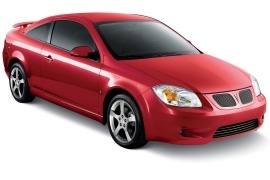PONTIAC G5 Models/Series Timeline, Specifications & Photos
First production year: 2004
Engines: Gasoline
General Motors realized that selling the Chevy Cobalt only under the bow-tie brand might not be such a good idea after all and re-badged it as a Pontiac G5 Coupe in 2007.
Chevrolet launched the Cobalt as a successor for the Cavalier in 2004 with four and two doors. Pontiac wasn't that eager to get its hands on the compact segment coupe. After all, it was an upmarket brand when compared to the fleet-oriented brand Chevrolet. But Pontiac started selling the Cobalt as a re-badged Pursuit in 2005 in Canada. In 2007, it introduced the G5 in the U.S.
Its coupe shape was inspired by its European cousin Opel Astra Coupe, with a similar-shaped roofline. Its tear-shaped headlights sported the turn signals at their upper corners, while the wrapped-around bumper featured the split Pontiac grille with a vertical slat in the middle. On the lower side, the carmaker added a trapezoidal grille with horizontal slats. The taillights found their place at the back of the quarter panels, without any additional lamps on the trunk lid. It was cheaper that way.
Inside, the carmaker installed bucket seats at the front with some bolstering on the sides. The G5 featured a simple, almost bland, dashboard design and a steering wheel that looked like it was carried over from an Opel/Vauxhall and re-badged with the Pontiac logo. The carmaker placed white dials for the speedometer and tachometer and a fuel gauge at the instrument panel's top.
Under the hood, Pontiac installed a choice of two engines ranged between 2.2-liter and 2.4-liter. The latter featured a variable-valve timing that boosted its power up to 175 hp.
General Motors produced a brand-engineered Chevrolet Cobalt model for the Canadian and Mexican markets and named it G5, and it produced it as a four-door sedan or as a coupe.
Badge engineering was not new, especially for General Motors. But it wasn't common for it to create a vehicle sold with a different badge only North and South of the U.S. borders. Yet, it did that with the Pontiac G5 sedan. Both vehicles were built on top of the GM's Delta platform, which was also used for the European Opel/Vauxhall Astra and the Chevrolet HHR. The main differences between the two siblings, the Cobalt, and the G5, were mainly on the aesthetic side.
The G5's front fascia sported the classic Pontiac split grille, with the brand's logo placed in the middle on a vertical slat. But changes went further by adding new headlights that sported an organic design and orange turn signals on their outer part. From its profile, the G5 featured the same greenhouse as the Cobalt and the Astra H, with a thicker C-pillar. Finally, at the back, the corner-mounted taillights were quite small and flanked the flat trunk lid.
Inside, GM didn't upgrade the materials or the finishes, and it looked more like a rental vehicle than an upscale version of the Cobalt. The base levels featured cloth upholstery and a cheap-looking instrument panel saved only by its white dials. Still, the carmaker provided the vehicle with standard AC, power windows, and power mirrors. The customers could enjoy the artificial leather, the sunroof, and the wood trims on the dashboard for the top-spec version.
Pontiac G5 received a choice of two gasoline-powered engines of 2.2 and 2.4-liter, respectively. The standard version came fitted with a five-speed manual, while a four-speed automatic was on the options list.

